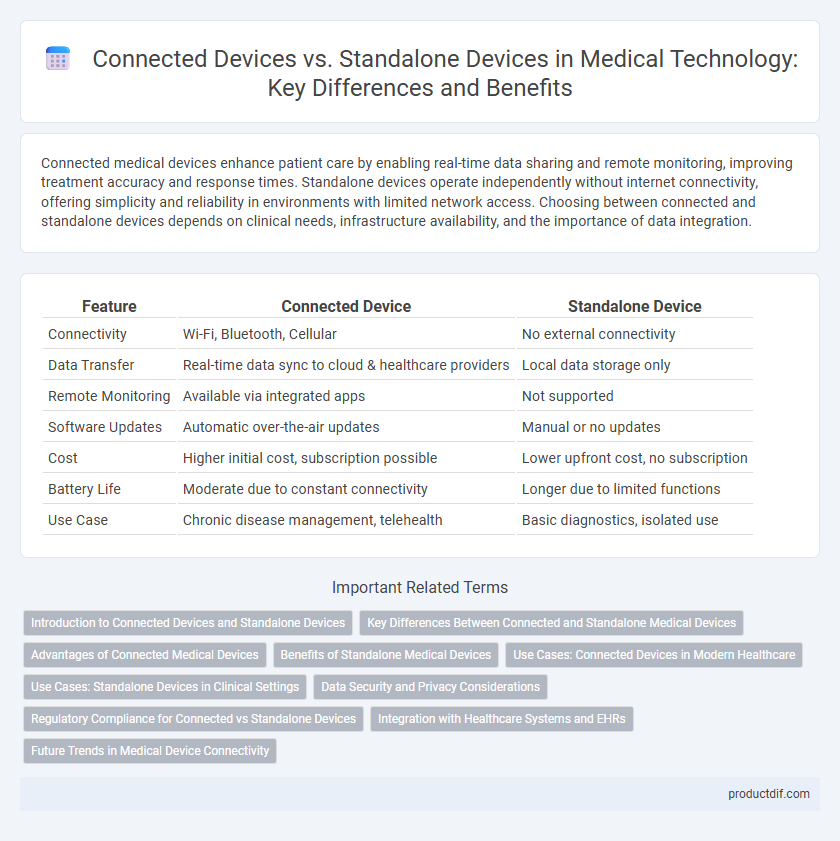Connected medical devices enhance patient care by enabling real-time data sharing and remote monitoring, improving treatment accuracy and response times. Standalone devices operate independently without internet connectivity, offering simplicity and reliability in environments with limited network access. Choosing between connected and standalone devices depends on clinical needs, infrastructure availability, and the importance of data integration.
Table of Comparison
| Feature | Connected Device | Standalone Device |
|---|---|---|
| Connectivity | Wi-Fi, Bluetooth, Cellular | No external connectivity |
| Data Transfer | Real-time data sync to cloud & healthcare providers | Local data storage only |
| Remote Monitoring | Available via integrated apps | Not supported |
| Software Updates | Automatic over-the-air updates | Manual or no updates |
| Cost | Higher initial cost, subscription possible | Lower upfront cost, no subscription |
| Battery Life | Moderate due to constant connectivity | Longer due to limited functions |
| Use Case | Chronic disease management, telehealth | Basic diagnostics, isolated use |
Introduction to Connected Devices and Standalone Devices
Connected medical devices integrate network capabilities to enable real-time data exchange, remote monitoring, and enhanced patient care through interoperability with healthcare systems. Standalone devices operate independently without network connectivity, relying solely on onboard functionalities for diagnostics and treatment. The choice between connected and standalone devices impacts clinical workflow, data accessibility, and patient engagement.
Key Differences Between Connected and Standalone Medical Devices
Connected medical devices enable real-time data sharing with healthcare systems, enhancing remote monitoring and timely interventions, whereas standalone devices operate independently without network integration. The connectivity in devices like wearable monitors improves patient outcomes by facilitating continuous data analysis and personalized care. Standalone devices offer simplicity and lower risk of cybersecurity issues but lack the comprehensive data exchange capabilities critical for modern telemedicine applications.
Advantages of Connected Medical Devices
Connected medical devices enable real-time remote monitoring and data sharing, enhancing patient care by allowing timely interventions and personalized treatment adjustments. Integration with electronic health records and other healthcare systems improves data accuracy and streamlines clinical workflows, reducing errors and administrative burden. Advanced analytics and continuous data collection support proactive disease management and improved patient outcomes compared to standalone devices.
Benefits of Standalone Medical Devices
Standalone medical devices offer enhanced reliability by functioning independently without requiring network connectivity, reducing risks associated with internet outages or cyberattacks. These devices provide easier compliance with regulatory standards such as FDA and ISO 13485 due to simplified software validation processes. Moreover, standalone devices often ensure quicker setup and operation in clinical settings, improving immediate patient care efficiency.
Use Cases: Connected Devices in Modern Healthcare
Connected medical devices enable real-time patient monitoring and data sharing across healthcare systems, improving diagnostic accuracy and personalized treatment plans. They facilitate remote patient management, reducing hospital readmissions and enhancing chronic disease care through continuous data transmission to healthcare providers. In contrast, standalone devices operate independently and offer limited data integration, making connected devices essential for advancing telemedicine and integrated healthcare networks.
Use Cases: Standalone Devices in Clinical Settings
Standalone medical devices, such as infusion pumps and vital signs monitors, enable direct patient care without relying on network connectivity, ensuring continuous operation during system outages. These devices facilitate rapid bedside interventions and real-time data collection, crucial for emergency and intensive care units where immediate response is vital. Their independent functionality reduces cybersecurity risks and simplifies compliance with healthcare regulations in clinical environments.
Data Security and Privacy Considerations
Connected medical devices transmit patient data over networks, increasing the risk of cyberattacks and unauthorized access, necessitating robust encryption, secure authentication protocols, and continuous monitoring to safeguard data integrity and confidentiality. Standalone devices, while less vulnerable to remote breaches, require stringent physical security measures and secure data storage to prevent local data theft or tampering. Both device types must comply with regulations such as HIPAA and GDPR to ensure comprehensive protection of patient privacy and data security.
Regulatory Compliance for Connected vs Standalone Devices
Connected medical devices require stringent regulatory compliance due to their integration with networks, necessitating robust cybersecurity measures and continuous software updates to ensure patient safety and data integrity. Standalone devices, while still subject to rigorous safety and efficacy standards by agencies like the FDA and EMA, face fewer cybersecurity requirements but must demonstrate consistent performance in isolation. Regulatory frameworks such as the FDA's Digital Health Precertification Program specifically address the lifecycle management and risk mitigation strategies essential for connected devices, highlighting the evolving landscape of medical device compliance.
Integration with Healthcare Systems and EHRs
Connected medical devices enable seamless integration with healthcare systems and electronic health records (EHRs), facilitating real-time data sharing and improved patient monitoring. Standalone devices operate independently, often requiring manual data transfer, which can lead to delays and data inconsistencies. Integration with EHRs enhances clinical decision-making, reduces errors, and supports coordinated care across healthcare providers.
Future Trends in Medical Device Connectivity
Future trends in medical device connectivity emphasize the shift from standalone devices to fully integrated connected systems that enable real-time data exchange and remote patient monitoring. Advanced IoT technologies and AI-driven analytics will enhance predictive maintenance and personalized treatment plans, driving smarter clinical decision-making. Enhanced cybersecurity protocols and interoperable standards will ensure secure and seamless communication across diverse medical platforms.
Connected device vs Standalone device Infographic

 productdif.com
productdif.com